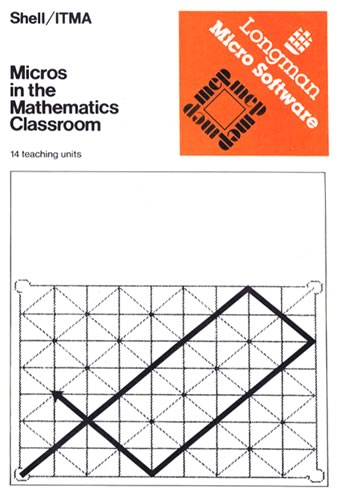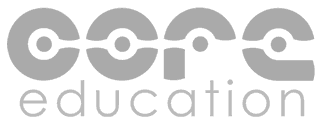Introduction
Micros in the Mathematics Classroom, Published by Longman, 1982
| Program & Credits | Description |
|---|---|
ASPIRDesign: Gordon Haigh, Sheldon Heath School, Birmingham Program: Gordon Haigh and Richard Phillips Source: Gordon Haigh © Gordon Haigh, 1982 |
"ASPIR is an investigative program about polygons. Although it is useful in teaching the geometry of regular polygons, its real value becomes apparent when investigating the whole range: concave polygons, irregular polygons, polygons with crossing lines, and combinations of these. The user draws an image on the screen by means of a sequence of instructions given in terms of angle and lines. This sequence may be repeated by the program until the pattern joins up. Pupils may be encouraged to see the relationship between such instructions and the polygon which results, and so learn to predict the one from the other." |
AUTOFRACDesign: Jon Coupland Progam: Jon Coupland Source: ITMA, Plymouth © Jon Coupland, 1982 |
"AUTOFRAC provides a continuous film-like display of equivalent fractions, in the form 8/4 =4/? Having been initiated, the program runs indefinitely without intervention from the user. Each pair of equivalent fractions, chosen at random, is displayed in its incomplete form for a specified time, after which the missing number is shown. The program then moves on to the next pair. The user may specify the level of difficulty required, and the delay time (in seconds) for which the unsolved problem is displayed." |
BARSETDesign: Graham Field, Rosemary Fraser, Jane Petty, Jan Stewart, Laurie Tate Program: Graham Field Source: ITMA, Plymouth © CET/College of St. Mark & St. John, 1982 |
"The program handles sets of pictograms of five objects prepared in advance (using BARPIC, a separate program) and of pets. There may be up to 5 of each object, with an overall maximum of 20 objects. These objects are first displayed at random and may then be moved into various arrangements" |
COUNTERSDesign: Anita Straker Program: Anita Straker and Graham Field Source: Anita Straker, Wiltshire Education Authority © Anita Straker, 1982 |
"COUNTERS is a game for two players, intended to strengthen knowledge of number bonds and to develop strategic thinking. The program displays a row of squares marked with the numbers 1 to 9. Players take turns to place their counters on uncovered squares. A player wins if he or she is the first to have three counters on squares whose numbers total exactly 15. The game may be repeated with the same or new players. If the same players continue, they take turns to begin." |
CWORDSDesign: Anita Straker Program: Anita Straker and Graham Field Source: Anita Straker, Wiltshire Education Authority © Anita Straker, 1982 |
"CWORDS ('counting words') is a drill-and-practice program intended for use by individual children or small groups. The program offers a test of verbal description of numbers within a predetermined range of values. If an incorrect answer is given, the child is invited to try again. This time, he or she is prompted with information as to the number of digits required. Should the second answer be wrong also, a special tuition page is displayed and the child prompted to complete the number digit by digit (Figure 3). At the end of the program, the teacher may have a report of scores of all children who have used the program. (Answers are taken as right if they were correct at either the first or the second attempt.)" |
DICECOINDesign: Alan Wigley Program: Alan Wigley Source: South Wolds School, Nottinghamshire © Alan Wigley, 1982 |
"This program could be the basis of many interesting investigations into probability. It simulates the throwing of a dice and tossing of coins, and uses graphs, histograms and tables to illustrate the patterns which emerge from random events." |
DIRECTEDDesign: Trevor Greenslade, Falmouth School, Cornwall Program: Trevor Greenslade, Colin Wells, Maggie Anderson Source: ITMA, College of St. Mark and St. John © CET, 1982 |
"DIRECTED uses the movement of a robot up and down a number line to help in the teaching of addition, subtraction and directed numbers. This is the first draft of the program which is under development - the final version will be available as a complete teaching unit later." |
ERGODesign: Richard Phillips Program: Richard Phillips Source: ITMA/Shell Centre for Mathematical Education © CET, 1982 |
"Twenty-five numbers, arranged in a five-by-five grid, form a pattern; only two of them are shown on the screen. The task is to discover the pattern and so fill in the missing numbers. the program is intended for the lower half of secondary school. Each problem is chosen at random from more than 1000 patterns. If the computer judges that you have discover a pattern, it will save you work and complete the problem for you. There are two levels of difficulty." |
EUREKADesign: Hugh Burkhardt, Richard Phillips and Malcolm Swan Program: Richard Phillips Source: Shell Centre for Mathematical Education/ITMA © Shell Centre for Mathematical Education, University of Nottingham, 1982 |
"EUREKA is designed to teach elementary graph interpretation. Under the user's control, it illustrates what happens to the water level in a bath when the bath is filled, when a man gets in, and when the plug is pulled out. These operations are shown pictorially in the upper part of the screen, while in the lower part a graph is plotted of water level against time. The program can be used to teach a number of aspects of graph interpretation and sketching. The idea of gradients can be discussed by considering the different gradients which result from filling the bath, from emptying it or from emptying it with the taps left on. Step functions are illustrated by the man entering and leaving the bath." |
FGPDesign: Richard Phillips, David Rooke and Alan Wigley Program: Richard Phillips Source: ITMA/Shell Centre for Mathematical Education © CET, 1992 |
"This is a general-purpose program to plot Cartesian graphs of most easily written functions. The user can choose the scales or opt for limited automatic scaling. Functions are entered in normal algebraic notation. Parameters can be changed, graphs can be superimposed and first derivatives can be plotted. Besides its use as an 'electronic blackboard', the program can be used to play 'guess the function' games and to fit curves to point data." |
PIRATESDesign: Rosemary Fraser, David Lee, Colin Wells Program: Colin Wells and Mike Allnut Sources: ITMA, College of St. Mark & St. John, Plymouth © College of St. Mark & St. John, 1982 |
"PIRATES is a treasure hunt. The treasure is hidden by the computer at a mesh point on an integral grid, and the treasure seeker approaches its hiding place by supplying 'guesses' expressed in coordinates. Each new 'guess' yields information which may be used in making next guess." |
SNOOKDesign: Jon Coupland Program: Jon Coupland Source: ITMA, College of St. Mark & St. John, Plymouth © CET/College of St. Mark & St. John, 1982 |
"SNOOK depicts a ball moving round a rectangular table until it falls into one of the pockets placed at each corner. The simulation encourages pupils to form hypotheses and to test these in a systematic manner. The path traced by the ball can be displayed for tables whose height and width, chosen each time by the user, are less than ten: results for larger sizes can be obtained in a text mode." |
SUBGAMEDesign: Brian Ives Program: Brian Ives Source: Brian Ives, Microcomputer Coordinator for North Yorkshire County Council © Brian Ives, 1982 |
"SUBGAME is a useful example of the different roles that a computer can play in the classroom. The program consists of a competition between the user and the computer to allocate digits to a subtraction sum so as to give the largest answer. The digits are generated randomly by the computer; the class decides where to place each in turn while the computer competes alongside with its own sum. (Note that the same digit may recur.) When all digits have been allocated, the computer calculates its own result, the class types its result and the winner, is the player with the largest answer. the computer displays a record of won, lost and drawn." |
TABCARDesign: Tony Haskins Program: Tony Haskins Sources: Birmingham Educational Computing Centre © Tony Haskins, 1982 |
"TABCAR provides practice in multiplication tables in the context of a car race. A correct answer moves your car forward a wrong answer advances the computer's car. Problems are chosen randomly, using integers between zero and twelve. Note that if you get the answer wrong, you are not told the correct answer." |
The computer for the individual |
"In this section, we give a few simple programs. You will undoubtedly want to amend them before use. A copy of each program listed here exists on disc, so there is no need for you to key the programs into the computer. The main purpose of this section is to illustrate the role of the computer as a teaching aid for the individual. The user can benefit both from using programs and from the process of programming itself." The programs include:
|


